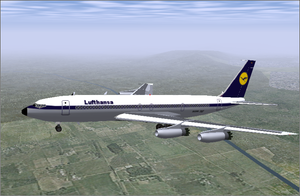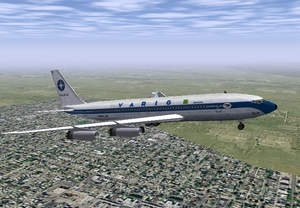Boeing 707-400: Difference between revisions
Jump to navigation
Jump to search
No edit summary |
(Switched to the Boeing 707-400/info documentation page for the aircraft infobox by transcluding {{:{{PAGENAME}}/info}}.) |
||
| (9 intermediate revisions by 4 users not shown) | |||
| Line 1: | Line 1: | ||
{{ | {{:{{PAGENAME}}/info}} | ||
The '''Boeing 707''' is a four-engine commercial passenger jet [[:Category:Airliners|airliner]] developed by [[:Category:Boeing|Boeing]] in the early 1950s. Its name is most commonly pronounced as "Seven Oh Seven". Boeing delivered a total of 1,010 Boeing 707s, and also offered a smaller, faster model of the aircraft that was marketed as the Boeing 720. | |||
== The 707-400 == | |||
The '''707-420''' is a version of the 707-320 originally produced at specific request for BOAC and powered by '''Rolls-Royce Conway 508 turbofans''', producing 17,500 lbf (77.8 kN) each. Although BOAC initiated the programme, Lufthansa was the launch customer and Air India was the first to receive a 707-420 on February 18, 1960. A total of 37 were built to this configuration. | |||
The '''707-420''' is a version of the 707-320 originally produced at specific request for BOAC and powered by '''Rolls-Royce Conway 508 turbofans''', producing 17,500 lbf (77.8 kN) each. Although BOAC initiated the programme, | |||
== External Links == | == External Links == | ||
* [http://www.boeing.com/commercial/707family/ Boeing 707 family on Boeing.com] | * [http://www.boeing.com/commercial/707family/ Boeing 707 family on Boeing.com] | ||
* [http://www.airlinercafe.com/page.php?id=72 Detailed guide to all variants of the 707/720 on airlinercafe.com] | * [http://www.airlinercafe.com/page.php?id=72 Detailed guide to all variants of the 707/720 on airlinercafe.com] | ||
| Line 42: | Line 12: | ||
== Reference == | == Reference == | ||
* [ | * [http://en.wikipedia.org/wiki/Boeing_707 Wikipedia] | ||
{{Boeing}} | {{Boeing}} | ||
[[pt:Boeing 707-400]] | |||
[[ | |||
Latest revision as of 15:22, 15 August 2016
| Prestes hangar | ||
|---|---|---|
 Lufthanse 707-400 | ||
 The VARIG 707-400 PAX | ||
| Type | Airliner | |
| Configuration | Low wing aircraft | |
| Propulsion | Quadjet (Jet aircraft, Four-engine aircraft) | |
| Manufacturer | Boeing | |
| Author(s) |
| |
| FDM | JSBSim | |
| --aircraft= | 707-400 | |
| Status | Alpha | |
| Development | ||
| Website |
| |
| License | Unknown | |
| ||
|
| ||
The Boeing 707 is a four-engine commercial passenger jet airliner developed by Boeing in the early 1950s. Its name is most commonly pronounced as "Seven Oh Seven". Boeing delivered a total of 1,010 Boeing 707s, and also offered a smaller, faster model of the aircraft that was marketed as the Boeing 720.
The 707-400
The 707-420 is a version of the 707-320 originally produced at specific request for BOAC and powered by Rolls-Royce Conway 508 turbofans, producing 17,500 lbf (77.8 kN) each. Although BOAC initiated the programme, Lufthansa was the launch customer and Air India was the first to receive a 707-420 on February 18, 1960. A total of 37 were built to this configuration.
External Links
- Boeing 707 family on Boeing.com
- Detailed guide to all variants of the 707/720 on airlinercafe.com
- Boeing 707 page on Airliners.net
Reference
| |||||||||||